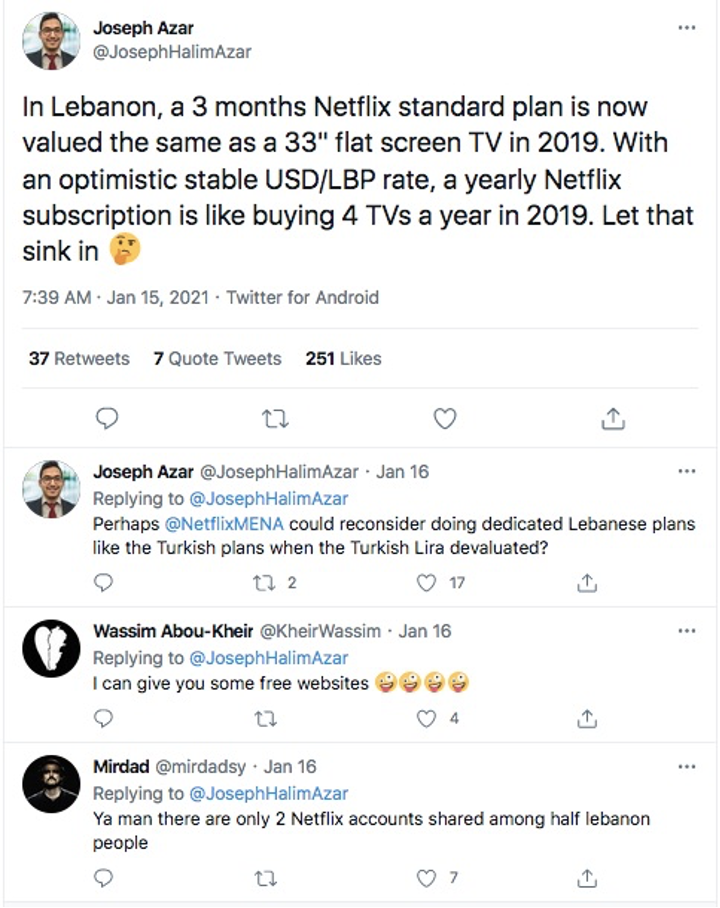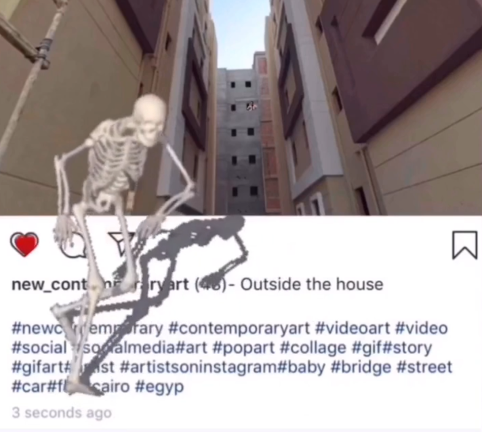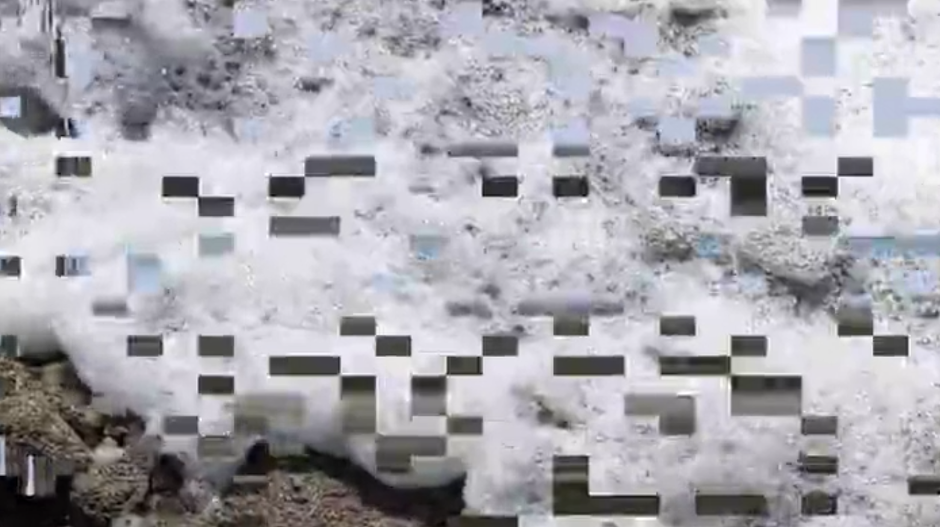New Filmic Geographies
We understand the provocation of "new filmic geographies" in two ways: as media geopolitics, explored in the first part by Laura, and as media geopoetics, explored in the second part by Radek. Our contributions are united by disdain for the ideology of unlimited media access and admiration for the artists and hackers who transform limited technical means into social and aesthetic abundance.
Streaming Media and Bandwidth Imperialism
The theme of this cluster of essays — "new filmic geographies" — invites us to celebrate audiences' increased capacity to access movies independent of their geographical location, thanks to streaming video. Doubtless this is a cosmopolitan and, to some degree, decolonizing development in cinema distribution, helping filmmakers find their audiences all over the world and connecting viewers to movies once obtainable only by the most determined efforts.
To such hopes of streaming-led global interlinkage, we speak as Cassandras. We are here to remind readers that streaming video, though it has a certain potential to unite people, is noxious for the planet. Streaming video was calculated in 2019 to be responsible for about 1% of global greenhouse gas emissions (GHG), a figure that has spiked during the COVID-19 pandemic.1 It will continue to rise as consumers worldwide — but especially in data-rich countries — seduced by the siren songs of video-on-demand platforms, telecoms, and mobile device manufacturers, find themselves streaming movies, You and other Tubes, pornography, and videos embedded in websites for hours a day, often in unnecessarily high resolution. That carbon footprint results from the majority of data centers' and networks' reliance on electricity derived from fossil fuels. The high turnover of mobile phones, whose production is electricity intensive, also contributes significantly to this footprint. Some researchers project that by 2030 — the year by which we must have cut emissions to 70% of 2005 levels in order to forestall catastrophic overheating of our planet2 — streaming will be responsible for 7% of global GHG.3 And this is one of the more modest calculations. Our informative and pleasurable media access is literally setting Earth on fire.
Let's think about the geopolitics of this untenable situation. I decided to focus on SWANA (Southwest Asia and North Africa) for this article, and Lebanon in particular, given that our convener, Suzanne Enzerink, is based at the American University in Beirut and I have learned so much from that region and that city.4 From Beirut viewers can stream (not without difficulty)5 programs of Lebanese and Arab independent cinema through streaming platforms such as: Aflamuna (Our Films); the veteran media organization Beirut DC; MC Distribution in Beirut (birthed from the sadly defunct Metropolis Cinema); and Aashra, Ashkal Alwan's monthly program of experimental media. Viewers inside and outside Lebanon can now partake of the region's vibrant media scene.
The lion's share of the global fireball that is streaming video resides within countries that boast robust media infrastructure, whose citizens stream media in ever-higher resolution and regularly chuck their devices when they are deemed obsolete. So-called data-poor countries make a much smaller contribution to that footprint. Less pecunious folks in less pecunious regions have little access to high-resolution streaming, hang onto their phones for a longer time, and are highly unlikely to invest in 4K televisions. The terms data-rich and -poor derive from environmental scientists Mathias Leidig and Richard M. Teeuw, who calculate the global digital divide, country by country, based on these variables: internet speed; hardware (number of computers per household); mobile phone subscriptions; mobile network coverage; internet users as percentage of population; and participation in higher education. Lebanon, despite its low income, scores fairly well by these standards, with a well-educated (at least until the recent economic crash) population and high mobile phone and internet usage.6 The country's low internet speed is the main factor that impoverishes it. (Yet young people in Lebanon, like their counterparts in richer countries, suffer from internet addiction7 — whose sad affects are compounded, as the media feed slows to a tantalizing drip, by the sensation of colonization.)
Leidig and Teeuw focus on the basic digital capacity necessary for disaster management, not for entertainment. High internet speed is not a criterion for survival, only for ease of pleasure. We dispute the necessity of fast internet, which is wasted on indulgences like indentureship to the internet of things, mostly useless innovations in electricity-devouring artificial intelligence, the climate crime that is Bitcoin, and high-resolution streaming movies on demand. But as infrastructure corporations colonize data-poor countries, and as more viewers all over the world, compelled by industry seductions as much as practical need, gain access to high-speed internet and the new devices it requires, data-poor countries' carbon footprint is rising.
Outside of a few urban elites, the majority of viewers in SWANA can't afford to subscribe to streaming services. Piracy has always been popular in the region: 23.4% of subscription television is pirated in SWANA plus Turkey (for comparison, in Canada it's 9.3%), and that spiked to 40% during the 2018 World Cup.8 The financial barriers to paid streaming are painfully evident in Lebanon, where consumers' means to pay in US dollars have evaporated since the financial crash of 2019. But poverty leads to remarkably communitarian, almost Christlike, workarounds, whereby not loaves and fishes but Netflix subscriptions multiply miraculously. This Twitter thread, courtesy of Suzanne Enzerink, sums up the situation with typically Lebanese sardonic wit:

Moreover, almost no one has access to high bandwidth: Lebanon has high internet use but crawling average internet speed. (Mobile devices in Lebanon get much faster download speeds than fixed broadband. This reflects the large investment in mobile media after much underground infrastructure was destroyed during the Lebanese civil war. Fixed broadband is run by the government company OGERO.9) Those who can afford to rely on VPNs (virtual private networks), which hide the user's location and IP address: handy for free speech and also for bootlegging streaming programs.10 Bonding VPNs like Speedify also increase download speeds by combining multiple internet channels, e.g. phone and broadband, or two phones with different service providers.
Lebanese audiences are skilled at hacks to bypass paid platforms, but are still stuck with slow speeds. I'm guessing, until I can do more research, that the most popular and accessible video streaming in Lebanon is on YouTube, especially TV shows and soccer, and that they are streamed in low resolution.
Streaming overrides national boundaries in quite physical ways. To calculate the carbon footprint of streaming media in a given region, we need to look at the source of electricity in that region, and also of the locations of data centers and networks outside the region through which streaming data passes. The locations of the data centers that stream media in Lebanon are beyond the scope of this research, but I can make an educated guess. The server might be Amazon Web Services's data hub in Luxembourg, or the company's new data hub established in Bahrain in 2019. Streaming data might also be hosted on a server hosted by a regional content distribution network (CDN). In Lebanon, there are three CDN companies: Cloudflare, Limelight, and Medianova.
Only 2% of Lebanon's electricity comes from renewable sources. The country purchases much of its electricity from Kuwait, Algeria, and Syria,11 and relies on polluting Turkish fuel-burning barges.12 (The Lebanese Ministry of Energy's National Renewable Energy Action Plan to produce 12% of the country's required energy from renewable resources by 2020 has not been followed up, according to the Lebanese Association for Energy Saving and for Environment, which itself ceased after 2015.) Bahrain too relies on oil for electricity. In Luxembourg, electricity is derived from coal. (Why are so many data centers based in regions that rely on coal?Probably: government subsidies of the fossil-fuel industry, which makes electricity artificially cheap in these places.)
So the carbon footprint of streaming in Lebanon is high. But fortunately for the planet, access is limited and resolution is low. The Lebanese streaming footprint per capita will likely never match that of countries with bloated infrastructure and fossil-fuel addictions, such as the United States, Canada, and South Korea.
Ramon Lobato suggests that the ideal of net neutrality — that all citizens should have equal access to high-speed internet — is "a vision that can never scale meaningfully in a global sense. It is grounded in a first-world idea of the internet, premised on an assumption of unbounded capacity. It does not ring true with how the internet is experienced in many countries."13 It is bandwidth imperialism to assume that other regions even want American-style, bingeable HD streaming.
Lobato is speaking about the finitude of streaming infrastructure; we add to it the finitude of the planet's carrying capacity. Some urban elites in data-poor countries will get their quick-reloading Netflix, but the vast majority must make do with slower and less. It is ridiculous to consider HD streaming movies and games a public utility. Instead, we advocate that the overdeveloped countries take ROW ("rest of world") as a model and learn to enjoy slow, interrupted, low-resolution media.
Most filmmakers desire that their work be seen in optimal circumstances of high resolution and, I must add, rapt and undistracted spectators. We have movie theaters and physical formats for that. At the same time, SWANA artists are already practiced at incorporating the malaises of demagnetization, compression, and glitch as affordances of the medium.14 It might not be fair to once again ask poor countries to school the bloated West in sustainable ways of living, but the planet's survival depends on it.15
Small-File Media Aesthetics and Politics
What can we do to reduce the carbon footprint of streaming media? Informatics scholars point out that computing research is predicated on a specific vision of the future that entails an ever-increasing production and consumption while ignoring the material impact of technology and the planetary limits.16 They propose a framework of computing within limits grounded upon the key principles (1) 'Question growth'; (2) 'Consider models of scarcity'; and (3) 'Reduce energy and material consumption.'17 How can these principles be implemented at the level of artistic and cultural production?
Laura founded the Small File Media Festival (SFMF; smallfile.ca) in 2020 as a way to question the vision of a universal future based on the idea of unstainable growth. The festival invited media makers to submit movies of no more than five megabytes in size and five minutes in duration. Over ten days in August 2020, SFMF screened over one hundred works by artists in sixteen countries, in ten different curated programs, to 165 attendees. The event was accompanied by panel discussions focusing on different perspectives on small-file media: makers' forums; a small-file aesthetics panel moderated by Clint Enns (lo-fi media maker and theorist, Montréal), with Mena El Shazly (Medrar for Contemporary Art, Cairo), Azadeh Emadi (Glasgow U), Radek Przedpełski, and Laura Marks; and a youth panel moderated by activist Sanjana Karthik. The documentation of the festival was compressed to small files before sharing on Vimeo. Through its constraint-based brief, careful programming, accompanying events, and its overall commitment to sustainable green media, SFMF has put forward a mode of critical making designed to change the habitual appetite for high-definition video, as reflected in the Jevons paradox: more efficient technologies encourage more use.
The festival's provocation was to introduce a type of filmic and artistic image that works within a determinate constraint in order to foster a spirit of joyous experimentation and creative imagination. Small-file movies submitted to the festival ponder the mystery, at the level of the pixel, of how an extreme compression of timespace can nonetheless engender new vast universes. And, by the same token, these small movies show how we can make do with less in the context of Anthropogenic environmental degradation, proposing a visually appealing alternative to high-resolution representational images. Small-time media index an era when we've learned that invisible dark matter and dark energy comprise the bulk of the universe, with visible matter accounting for only 5%, while the earth itself is criss-crossed by the invisible filaments of data networks and pandemic viral circulations.
Small-file images plunder Godard's formula pas une image juste, juste une image and make it into an algorithm for speculative world-building. These small filmic images suggest alternative visions of the cosmos, even if they are made of mere pixels or barely perceptible incremental changes between still frames. The movies we have been gifted with are robustly material, porous and incomplete: human figures peel away in splendorous pixels; backgrounds drown in noise; everything seems to melt in a solar flare; visibility gives way to the modulations of zones of darkness and seething aggregates of sound; seamless narration opens to gaps appearing in the cracks between the frames; executables swarm with algorithmic patterns; improbable scenarios come life and different timelines are combined within a single frame. (All the movies I describe below can be seen at the 2020 festival archive at smallfile.ca.)
Take Azadeh Emadi's string of trembling microscopic impressions of quotidian objects in Entangled Orb, which are no longer memories of past events but sensitive talismans imbued with the potential to open up passages to new worlds. And all this within the flutter of an eyelash. A Lynchian portal, a pool of scintillating color, basking in the haze of William Blake's tiger-image and the endoscopic intimacy of Mona Hatoum's 1994 Corps étranger installation.

Taken together, the movies we received at the 2020 festival create a decentered multitude that sounds a manifesto for alternative ways of making and encountering art and of making (media) art relevant for present social, political, and environmental issues. Small-file media are inherently political in privileging the potential of the unseen and the invisible by focusing on sound and the tactile qualities of the image as well as mobilizing other senses, rather than approaching the image in terms what it represents — as a composition of determinate figures sharply outlined against a set background. They are also unashamedly queer in their art of failure to buy into the culture of progress and success, to echo Jack Halberstam's beautiful book, and, at the same time, meditative and spiritual. Paradoxically, even if they last mere minutes, small-file movies take time to unfold, as it takes time to let them sink in. In this sense, they are opposed to the instant gratification of the Instagram image — given all at once and in great number. (Although some of our artists, like Cairo-based Hany Rashed, chose to lodge themselves onto this platform to stretch it to its limits and subvert its clichés).


Small-file media do not race to keep up with the progress or your daily fitness app; they are Bergsonian in their capacity to unfold infinite duration from a split second of chronometric time. These tiny artworks invent ways of experiencing them. Above all, they are not serious but act like shape-shifting tricksters who bend the rules, making us laugh, wonder, and desire. In doing so, they draw new filmic geographies of affect. Leanne Dunic's Melt, for example, features a stalactite whose power to melt on contact with warmer temperatures is imbued with desire, while Pierre Leichner's Dough Porn #1 enacts Paul B. Preciado's Countersexual Manifesto through a coupling of plasmatic figures with transitory organs. Leichner's weird take on porn stages an encounter of two dough bodies whose poorly differentiated protrusions touch one another, and an undifferentiated lump even migrates between the two in the process. Such unnatural coupling demonstrates the potential for corporal plasticity beyond the normative, closed borders of an organism. In this way, Dough Porn #1 becomes an exercise is what Preciado calls dildotectonics defined as the "counterscience that studies the appearance, formation, and utilization of the dildo" which "assumes consideration of the body as a surface and territory, a site of the dildo's displacement and emplacement."18


Small-file movies preposterously revive the art of the miniature to bore holes in the monumental sublime of contemporary AI- and VR-enabled blockbusters of the mainstream global art world. They expose, for example, Refik Anadol's expansive 2021 Quantum Memories, featuring millions of images turned into an imposing 10 x 10 meter visualization via Google AI, or Marina Abramović's 2018 VR performance Rising that articulates a call for environmental awareness but glosses over the carbon footprint of its own streaming. These are vast operatic pieces that would not be out of place in a spectacular ancient Graeco-Roman temple. In contrast, the smallest small-file movie in the 2020 festival, Daniel Carter's online vector animation Star Trek: Voyager Intro in 283kb does what it says on the tin and more — its pixel ghost of a starship surveys infinite expanses of a small bounding box embedded into a website. And yet this infinitesimal piece collapses the ideology of progress evident in Anadol's and Abramović's pieces.

The small-file media image does not reside on a physical screen but is emitted as an image-particle, image-force, or image-energy. It finds commonalities with Bronislaw Szerszynski's concept of "colloidal sociology" taking its cue from colloidal substances, i.e. "sols, foams, powders, gels, doughs, and pastes that exhibit complex and shifting macroscale physical properties that do not conform to standard conceptions of solids, liquids, or gases."19 In Derek Kwan's bombaybeach, Tetris-like pixel aggregates merge with a close-up footage of seething seafoam; it is a work of colloidal aesthetics — both foam and pixel are exposed as liminal, interstitial beings, neither solid, gas, or liquid, operating on a meso scale with unforeseen consequences.

Last but not least, drawing archaeologies of small-file media is an exciting and important part of the small-file media aesthetics and politics. It is yet another way in which tiny media contribute to understanding new filmic geographies. The encounter with small-file artworks invites a vertigo of speculations about their possible precedents. It empowers audiences from all around the world to link small-file aesthetics to different practices and contexts from the past, and therefore jointly decolonize contemporary media studies by giving prominence to marginalized voices and aspects rendered obsolescent by the unrelenting bulldozer of globalized progress. In this way, small-file movies assume a long afterlife as subjects of numerous discussions and debates.
Hence, one might preposterously claim that the functioning of small-file media is already described by Ṣadr al-Dīn al-Shīrāzī's (also known as Mullā Ṣadrā) (1571-1641) concept of substantial motion.20 Small-file movies function as a lens bringing together Arte Povera with practices operating in the 1970s within different regional socialist contexts: Sudanese Crystalist school thinking about "the crystal [as] nothing but the denial of the objectification of objects"21 and Jerzy Ludwiński's alternative vision of (the history of) art as material and energetic transformations.22 The infinite line of small-file concepts still keeps unfolding . . .
Laura U. Marks works on media art and philosophy with an intercultural focus and an emphasis on appropriate technologies. She is the PI of the research group Tackling the Carbon Footprint Streaming Media and the founder of the Small File Media Festival, smallfile.ca. Her most recent book is Hanan al-Cinema: Affections for the Moving Image (MIT, 2015). With Azadeh Emadi she is a founding member of the Substantial Motion Research Network. She programs experimental media art for venues around the world. Marks is Grant Strate Professor in the School for the Contemporary Arts at Simon Fraser University in Vancouver, Canada.
Radek Przedpełski (his/him @Radik_Przedpe) is a migrant artist, aesthetics and media culture scholar lecturing at Trinity College Dublin. Currently a postdoctoral research associate on the Tackling the Carbon Footprint of Streaming Media transdisciplinary project developed at Vancouver's Simon Fraser University (SFU) by Profs. Laura Marks and Stephen Makonin. Co-editor of Deleuze, Guattari and the Art of Multiplicity published by Edinburgh University Press in 2020
References
- The Shift Project, "Climate Crisis: The Unsustainable Use of Online Video" (2019); Sandvine's "The Global Internet Phenomena Report" (May 2020), states that internet usage as a whole spiked by 40% during the first months of the pandemic, led by streaming video.[⤒]
- The Paris Agreement: United Nations Framework Convention on Climate Change (2016). [⤒]
- Lotfi Belkhir and Ahmed Elmeigli, "Assessing ICT global emissions footprint: Trends to 2040 & recommendations," Journal of Cleaner Production 177 (2018): 448-463.[⤒]
- See for example, Laura U. Marks, Hanan al-Cinema: Affections for the Moving Image (Cambridge, MA: MIT Press, 2015).[⤒]
- Aflamuna's launch in February 2021 was delayed for three weeks by technical problems.[⤒]
- Mathias Leidig and Richard M. Teeuw, "Quantifying and Mapping Global Data Poverty," PLoS One 10, no. 11: e0142076. November 11, 2015.[⤒]
- See for example Sahar Obeid et al., "Internet Addiction Among Lebanese Adolescents: The Role of Self-Esteem, Anger, Depression, Anxiety, Social Anxiety and Fear, Impulsivity, and Aggression—A Cross-Sectional Study," The Journal of Nervous and Mental Disease 207, no. 10 (October 2019): 838-846[⤒]
- Sandvine, "The State of Affairs: Video and Television Piracy Worldwide," 2020 white paper; Cam Cullen, "Global Internet Phenomena: World Cup Piracy Snapshot," July 31, 2018.[⤒]
- According to Speedtest, in December 2020 Lebanon ranked 156 globally for broadband (out of 177 countries surveyed) and 53 for mobile. During the pandemic OGERO was suddenly able to double internet speed.[⤒]
- Shahmeer Baloch, "Best VPN for Lebanon 2021 - Safe, Secure & Reliable," updated January 12, 2021. [⤒]
- Sunniva Rose, "Syria is selling electricity to Lebanon despite its war-ravaged infrastructure," The National (UAE), April 2, 2019. [⤒]
- Leila Molanna-Allen, "Lebanon's power barges pay a heavy environmental price," France 24, August 27, 2018. [⤒]
- Thomas Lobato, Netflix Nations: The Geography of Digital Distribution (New York: New York University Press, 2019), 93.[⤒]
- Laura U. Marks, "Arab Glitch," in Uncommon Grounds: New Media and Visual Practice in the Middle East and North Africa, ed. Anthony Downey (I.B. Tauris/Ibraaz Publishing), 257-271; see also the chapter "Algorithm, Decryption, Glitch," in Marks, Hanan al-Cinema: Affections for the Moving Image (Cambridge, MA: MIT Press, 2015).[⤒]
- Many thanks to Suzanne Enzerink for bolstering my research with reports from Beirut![⤒]
- Bonnie Nardi, Bill Tomlinson, Donald J. Patterson, Jay Chen, Daniel Pargman, Barath Raghavan, and Birgit Penzenstadler, "Computing Within Limits," Communications of the ACM, 61, no. 10 (October 2018): 86.[⤒]
- Ibid, 90-92. [⤒]
- Paul B. Preciado, Countersexual Manifesto, trans. Kevin Gerry Dunn (New York: Columbia University Press), 41.[⤒]
- Bronislaw Szerszynski, "Colloidal Social Theory: Thinking about Material animacy and sociality beyond Solids and Fluids." Unpublished manuscript, 2020. Szerszynski "relate[s] colloids, with their twin phenomena of 'repetition' and 'mediation', to an understanding of social life as reducible neither to the interaction between separate individuals nor to a transindividual whole." (Ibid.) As he further clarifies, "human social life participates in a colloidal 'metapattern' of repetition and mediation that is manifest across diverse material substrates and spatial scales" (Ibid.).[⤒]
- Azadeh Emadi, "Reconsidering the Substance of Digital Video from a Sadrian Perspective," Leonardo, 53, no. 1 (2020): 75-80. As Emadi (Ibid., 75) explains, Ṣadrā "proposed that substance (material/visible and immaterial/invisible) undergoes an internal change, creating intimate connections between the smallest parts and the One, visible and invisible." According to Emadi, "we can think of these dynamic connections in terms of pixels and frames. From the view of Sadra ̄'s substance, pixels are explored as open to change" (Ibid.).[⤒]
- Abdallah, Hassan, Hashim Ibrahim, Kamala Ibrahim Ishaq and Muhammad Hamid. [1976] 2018 "The Crystalist Manifesto," Post: Notes on Art in a Global Context, The Museum of Modern Art (accessed February 5, 2021).[⤒]
- see Jerzy Ludwiński, Notes from the Future of Art: Selected Writings by Jerzy Ludwiński, ed. Magdalena Ziółkowska (Eindhoven: Van Abbemuseum, 2007). Ludwiński sees art as a peculiar mountain, which dynamically "accretes into its depth and towards its middle". Researching art is therefore a type of archaeology that necessitates that one "pierces through the clamour until complete silence, and only then we will be able to comprehend less." In: Jerzy Ludwiński [1982] (2009b), 'Góra' [The Mountain], in Jarosław Kozłowski (ed.), Sztuka w epoce postartystycznej i inne teksty [Art in the Post-Art Epoch and Other Texts], Poznań: Akademia Sztuk Pięknych; Wrocław: Biuro Wystaw Artystycznych, 157-158.[⤒]
